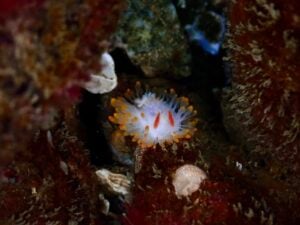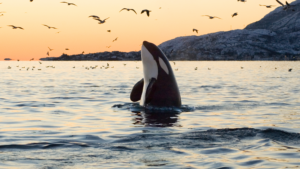Marine protected areas (MPAs) are superchargers of abundance that boost fish stocks and create the conditions for strong, sustainable local fisheries. Numerous studies have found that fish and marine life abundance within well-managed MPAs increases by almost seven times compared to similar non-MPA areas. This means MPAs produce not only more, but also larger fish. MPAs are essential for helping critical marine ecosystems recover from overfishing, as MPAs protect vital marine habitats, such as breeding and feeding grounds. Setting aside sections of the ocean for MPAs is essential for ensuring the health of oceans and the economic survival of coastal communities. MPAs will ensure that the Great Bear Sea remains a thriving food system with productive fishing grounds for future generations.

How Does Spillover Work?
Fish spillover is one of the key economic benefits of marine protected areas. By providing safe havens where fish populations can grow in size and number without the pressure of fishing, marine protected areas help to replenish fish stocks. As fish populations exceed the carrying capacity of the protected area, individuals, including larvae and eggs, move into adjacent fishing grounds, potentially increasing catch rates and supporting local fisheries. This movement can lead to improved yields for fishermen operating near the borders of MPAs, thus supporting the argument for MPAs as a tool for sustainable fisheries management. The Marine Conservation Institute defines spillover as follows: “As protected fish populations become larger, more of them are likely to spill beyond the invisible boundaries of the MPA.”
The Economic Benefits of Marine Protected Areas: Fish Spillover
Resident Fish Spillover
A study published in 2014 by Edgar et al. analyzed 87 marine protected areas worldwide and found that fish biomass inside no-take marine reserves was, on average, 670% greater than in similar unprotected areas. This increase in biomass drives the spillover effect, as fish inside the protected area move into adjacent fishing grounds. Numerous studies on marine protected areas have found that the catch rates of resident fish in fishing grounds adjacent to MPAs increase significantly. A study of an MPA in California found that while the MPA decreased fishing ground size by 35%, the sustainable catch rate in adjacent fishing grounds has increased by 245%. A 2024 meta-analysis of the literature by Costello found that fisheries adjacent to marine protected areas “had up to 45 times higher catch per unit effort (CPUE) and 40 times higher catch,” with there also being increased fish size as well as significant larvae and juvenile export from the MPA to surrounding non-protected areas.
Despite opponents arguing that MPAs create economic hardships for local fishers, the opposite seems true in well-managed MPAs. MPAs protect and sustain marine ecosystems and enhance resident fish stocks inside their boundaries and adjacent fishing grounds, resulting in sustainable fisheries. The economic benefits of spillover illustrate that MPAs have the strong potential to protect food systems and economies instead of eliminating them.

Migratory Fish and The Spillover Effect
The benefits of marine protected areas do not stop at resident fish. A recent study from the Universities of Hawaii and Wisconsin-Madison found that the MPA spillover effect also applies to migratory fish. In this study conducted in the MPA of Papahānaumokuākea Marine National Monument in Hawaii, the researchers found that catches of the migratory yellowfin tuna increased by 54% in fishing grounds adjacent to the MPA. According to researcher Jennifer Raynor, “the protected area could be doing one of two things. The first is that these fish populations are increasing because the areas provide nurseries for baby fish, and some are spilling over into nearby areas. A second reason might be that fish are just finding a safe place to aggregate, near the protected area, where they can’t be caught.” This research illustrates another benefit the Great Bear Sea MPA Network could bring to BC’s coast, as it has the potential to positively impact the populations of migratory species, such as Chinook salmon, a species that is important for our coastal economy.

Conclusion
With marine protected areas, there will be an increase in fish biomass and reproductive success. Some of these fish will grow, reproduce, and eventually move outside the MPAs, where they can be harvested sustainably, benefitting both marine ecosystems and local fisheries on our coast. Here’s a step-by-step look at how fish spillover works:
1. Marine Protected Areas -> Reduced Pressure: Inside the MPA, fishing activities are restricted or prohibited, allowing fish populations to recover and thrive. This leads to higher fish densities and larger fish within the protected area.
2. Reduced Pressure -> Reproduction and Growth: With reduced fishing pressure, fish within the marine protected area have more opportunities to reproduce, and their offspring have a higher chance of survival. This results in increased recruitment of juvenile fish.
3. Growth -> Larvae and Fish Movement: Fish, including those born and growing up within the marine protected area, tend to move beyond the MPA boundaries in search of food and suitable habitats as well as to reproduce. These fish can travel into adjacent fishing areas. Larvae and eggs also spill over into areas outside of the protected zone.
4. Movement -> Spillover Effect: As adult fish migrate out of the marine protected area, they can be caught by fishermen in adjacent fishing grounds. This provides a source of sustainable fishing and can lead to increased catch rates, benefiting local fisheries.
5. Spillover -> Enhanced Reproduction: The presence of larger, more fertile individuals outside marine protected areas can also enhance reproductive success in neighbouring areas, as they may produce more and higher-quality offspring.
The spillover effect helps maintain fish populations in both the protected and open-access areas, contributing to the resilience of marine ecosystems and supporting sustainable fisheries.




